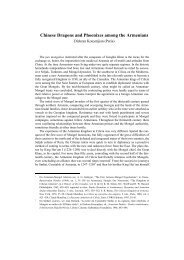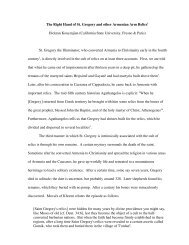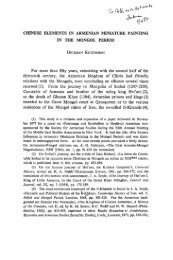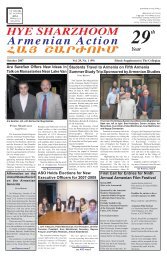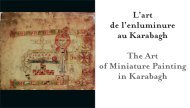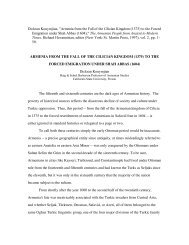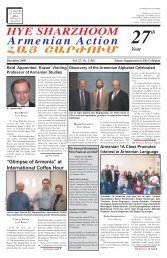Sirarpie Der Nersessian (1896-1989). Pioneer of Armenian Art History
Sirarpie Der Nersessian (1896-1989). Pioneer of Armenian Art History
Sirarpie Der Nersessian (1896-1989). Pioneer of Armenian Art History
Create successful ePaper yourself
Turn your PDF publications into a flip-book with our unique Google optimized e-Paper software.
I do not think she would have approved <strong>of</strong> such a description, even though she never<br />
married and much <strong>of</strong> her adult life, in the personal realm, was shared with women.<br />
Motherless at age nine, fatherless at eighteen, she lived with her aunt (1914–18) and<br />
her sister, Arax, until the latter’s marriage, but the untimely death <strong>of</strong> her sister’s<br />
husband in 1947 brought the sisters together again. Arax died a few years before<br />
<strong>Sirarpie</strong> after a long illness. The <strong>Der</strong> <strong>Nersessian</strong> sisters shared a common house at<br />
Dumbarton Oaks (1947–63), known afterward as the “<strong>Der</strong> <strong>Nersessian</strong> house,” and an<br />
apartment in the sixteenth arrondissement <strong>of</strong> Paris. Though she was regarded by<br />
students and even colleagues as an extremely well organized teacher, researcher, and<br />
administrator, she was also known for her keen sense <strong>of</strong> humor; for example, during<br />
a social gathering when she was asked, “Where is your husband, Pr<strong>of</strong>essor <strong>Der</strong> <strong>Nersessian</strong>?”<br />
she quipped, “I am the husband.” 9<br />
Though she was a pioneer as a female medievalist, she never made much <strong>of</strong> it. She<br />
was the Wrst woman to teach Byzantine art in a woman’s college, the Wrst woman to<br />
be decorated with the very distinguished medal <strong>of</strong> Saint Gregory the Illuminator by<br />
His Holiness Catholicos Vazgen I (1960), the Wrst woman invited to lecture at the<br />
prestigious Collège de France in Paris, the only woman in her time to gain full pr<strong>of</strong>essorship<br />
at Dumbarton Oaks, and the second woman to be honored with a gold<br />
medal from the Society <strong>of</strong> Antiquaries <strong>of</strong> London (1970).<br />
While teaching in America, she Wnally completed her French doctorate with the<br />
required two major dissertations, both published in 1936–37: one devoted to Byzantine<br />
manuscript illumination, L’Illustration du “Roman de Barlaam et Joasaph,” and the other<br />
to <strong>Armenian</strong> miniatures, Manuscrits arméniens illustrés des 12e, 13e, et 14e siècles de la Bibliothèque<br />
des Pères Mekhitharistes de Venise. Each <strong>of</strong> these books received a special prize. 10<br />
Thus, Byzantine and <strong>Armenian</strong> manuscript studies were to be the poles <strong>of</strong> a career<br />
extending over six decades.<br />
Though scholars before her had studied <strong>Armenian</strong> manuscript art—notably Father<br />
and later Catholicos Garegin Yovsēp’ian—it was <strong>Der</strong> <strong>Nersessian</strong> who established the<br />
parameters <strong>of</strong> the discipline and provided a conceptualization <strong>of</strong> its scope and characteristics.<br />
She was always known for her sense <strong>of</strong> organization and order. Because<br />
she was so Wrmly grounded in Byzantine and European art with a Wne appreciation<br />
<strong>of</strong> Islamic painting as well, <strong>Der</strong> <strong>Nersessian</strong> was able to demonstrate that <strong>Armenian</strong><br />
art was not just a provincial oVshoot <strong>of</strong> Byzantine art but a distinct cultural expression<br />
with its own characteristics. Building on the studies <strong>of</strong> Yovsēp’ian and always<br />
using clear language replete with concrete references, she laid out the essentials <strong>of</strong><br />
<strong>Armenian</strong> iconography, deWned the styles <strong>of</strong> various periods, reconstructed numerous<br />
workshops, and revealed the characteristic features <strong>of</strong> the most proliWc painters.<br />
This was <strong>of</strong>ten done in conjunction with the publication <strong>of</strong> catalogs <strong>of</strong> important<br />
collections <strong>of</strong> illuminated <strong>Armenian</strong> manuscripts: the Mekhitarist Library Collection<br />
in Venice (partial); the Chester Beatty Collection, Dublin; the Freer Gallery <strong>of</strong> <strong>Art</strong>,<br />
Washington, D.C.; the Walters Gallery <strong>of</strong> <strong>Art</strong>, Baltimore; the Library <strong>of</strong> the <strong>Armenian</strong><br />
Prelacy, New Julfa, Isfahan. 11 Dickran Kouymjian 485



